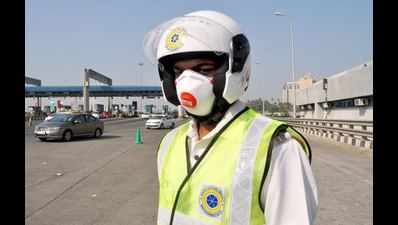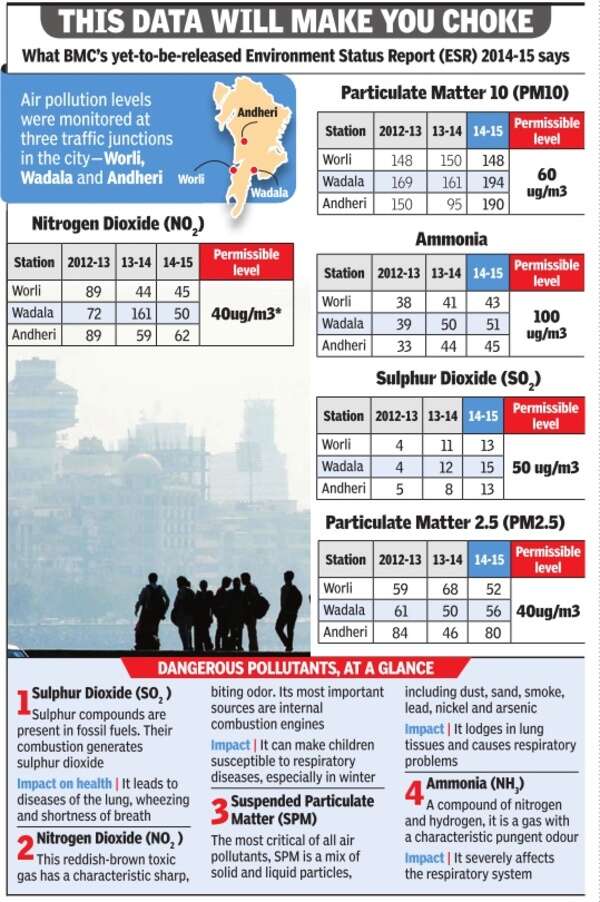- News
- City News
- mumbai News
- Mumbai: Air you breathe has more SO2, ammonia now than 3 yrs ago
Trending
This story is from August 26, 2015
Mumbai: Air you breathe has more SO2, ammonia now than 3 yrs ago
The city seems to be getting less livable due to consistent year-on-year increase in air pollutants.

The city seems to be getting less livable due to consistent year-on-year increase in air pollutants.
MUMBAI: The city seems to be getting less livable due to consistent year-on-year increase in air pollutants.
Data accessed by TOI from the BMC’s yet-to-be-released Environment Status Report (ESR) 2014-15 has quantified the increase since 2012-13.
Air pollution levels were monitored at three traffic junctions in the city—Worli, Wadala and Andheri. The results indicated that suspended particulate matter (SPM), ammonia and sulphur dioxide (SO2) levels have gone up at varied pace in different localities across the city.
READ ALSO: Delhi air pollution: A hara-kiri in waiting!
READ ALSO: Choking India gets air quality index
The report points to an increase in SO2 and ammonia levels at most traffic junctions. PM2.5 and PM10 levels have risen most significantly at Worli.

Dr Rakesh Kumar, chief scientist, National Environmental Engineering Research Institute (Neeri), says there is “a great need” to think why pollution levels are rising. “Increase in congestion has led to a corresponding rise in pollution levels. Earlier, we would discuss how vehicular engines were not being maintained, which added to the pollution. That is not the case today, as a vehicle’s shelf life itself is not more than four to five years.”
Kumar blamed the inadequate public transport system for the spike.
“This city traditionally preferred public transport but with constant fare hikes, many people see little difference in the cost of using their own vehicles and taking public transport. They have therefore switched over to their personal transport,” said Kumar.
It also states that the air is relatively cleaner during monsoon as pollutants disperse due to turbulence and rain.
Sumaira Abdulali, environmentalist and convenor of the NGO Awaaz Foundation, said that Mumbai seems to be becoming a hub for all kinds of respiratory diseases, all thanks to rising pollution. “Many a times, there is a realization that grave diseases are an outcome of respiratory disorders. It is not just vehicles that lead to a rise in pollution levels but also several other activities in the city, including large-scale construction, inadvertent fires, especially during festivals, frequent use of fire crackers and small-scale industries that release toxic gases,” said Abdulali.
Dr Rohini V Chowgule, director, Indian Institute of Environmental Medicine, said, “Pollutants like PM and NO2 are harmful to those with heart and lung issues. Besides, people who exercise by running on streets must make sure they don’t run near busy traffic junctions, as they may be inhaling pollutants.”
Data accessed by TOI from the BMC’s yet-to-be-released Environment Status Report (ESR) 2014-15 has quantified the increase since 2012-13.
Air pollution levels were monitored at three traffic junctions in the city—Worli, Wadala and Andheri. The results indicated that suspended particulate matter (SPM), ammonia and sulphur dioxide (SO2) levels have gone up at varied pace in different localities across the city.
READ ALSO: Delhi air pollution: A hara-kiri in waiting!
The ESR report shows the NO2 level in Worli, for instance, increased from 44 ug/m3 (micrograms per cubic metre of air) in 2013-14 to 45 ug/m3 in 2014-15—above the permissible standard of 40 ug/m3. Then, particulate matter 10 (PM10) at Wadala junction increased from 161 ug/m3 to 194 ug/m3 during the period—way higher than the limit of 60 ug/m3.
READ ALSO: Choking India gets air quality index
The report points to an increase in SO2 and ammonia levels at most traffic junctions. PM2.5 and PM10 levels have risen most significantly at Worli.

Dr Rakesh Kumar, chief scientist, National Environmental Engineering Research Institute (Neeri), says there is “a great need” to think why pollution levels are rising. “Increase in congestion has led to a corresponding rise in pollution levels. Earlier, we would discuss how vehicular engines were not being maintained, which added to the pollution. That is not the case today, as a vehicle’s shelf life itself is not more than four to five years.”
Kumar blamed the inadequate public transport system for the spike.
“This city traditionally preferred public transport but with constant fare hikes, many people see little difference in the cost of using their own vehicles and taking public transport. They have therefore switched over to their personal transport,” said Kumar.
It also states that the air is relatively cleaner during monsoon as pollutants disperse due to turbulence and rain.
Sumaira Abdulali, environmentalist and convenor of the NGO Awaaz Foundation, said that Mumbai seems to be becoming a hub for all kinds of respiratory diseases, all thanks to rising pollution. “Many a times, there is a realization that grave diseases are an outcome of respiratory disorders. It is not just vehicles that lead to a rise in pollution levels but also several other activities in the city, including large-scale construction, inadvertent fires, especially during festivals, frequent use of fire crackers and small-scale industries that release toxic gases,” said Abdulali.
Dr Rohini V Chowgule, director, Indian Institute of Environmental Medicine, said, “Pollutants like PM and NO2 are harmful to those with heart and lung issues. Besides, people who exercise by running on streets must make sure they don’t run near busy traffic junctions, as they may be inhaling pollutants.”
End of Article
FOLLOW US ON SOCIAL MEDIA










